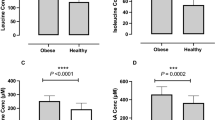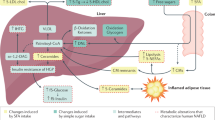Abstract
OBJECTIVE: To investigate whether improvements in cardiovascular risk factors, as observed in energy-balance conditions after exchanging carbohydrates (CHO) for monounsaturated (MUFA) fats, are also observed in energy-restricted conditions.
DESIGN: Longitudinal, clinical intervention study using two types of energy-restricted diets (−30% of initial energy intake) with similar levels of saturated and polyunsaturated fats: a high CHO diet (55% of energy from CHOs, 10% from MUFAs) and a high MUFA diet (40% of energy from CHOs, 25% from MUFAs).
SUBJECTS: A total of 32 overweight subjects (nine males, 23 females, BMI: 26–45 kg/m2).
MEASUREMENTS: Body weight, serum lipids, fasting plasma insulin and phospholipid fatty acid composition of red blood cells were measured at baseline and after 8 weeks. Various oxidative status parameters (plasma lipid hydroperoxides, total plasma antioxidant capacity, plasma uric acid and vitamin E) and serum-induced smooth muscular cell (SMC) proliferation were also measured at these time points.
RESULTS: Weight loss (1.1 kg/week over the first 4 weeks and 6.7 kg at week 8) was not significantly affected by the diet composition. Both diets reduced significantly total serum cholesterol, but the MUFA-rich diet showed better effects on fasting serum triacylglycerol (TG) than the CHO-rich diet: 1.18 vs 1.51 mmol/l for the MUFA-rich diet (after vs before, P<0.05) and 1.42 vs 1.62 for the CHO-rich diet. After 8 weeks, plasma vitamin E concentrations were positively associated with the oleic acid level of red blood cell phospholipids and showed opposite variations in both diets (increase with the MUFA-rich diet and decrease with the CHO-rich diet). Relative changes in SMC proliferation induced by sera were negatively associated with the ratio oleic:linoleic acid of red blood cell phospholipids and were significantly higher with the CHO-rich diet.
CONCLUSIONS: The MUFA-rich diet showed better effects on serum TG than the CHO-rich diet, even with energy restriction and weight loss. The results suggest also a protective effect of oleic acid on oxidative stress and SMC proliferation, two other important cardiovascular risk factors.
This is a preview of subscription content, access via your institution
Access options
Subscribe to this journal
Receive 12 print issues and online access
$259.00 per year
only $21.58 per issue
Buy this article
- Purchase on Springer Link
- Instant access to full article PDF
Prices may be subject to local taxes which are calculated during checkout


Similar content being viewed by others
References
Ceriello A . Oxidative stress and glycemic regulation. Metabolism 2000; 49(Suppl 1): 27–29.
Haffner SM . Clinical relevance of the oxidative stress concept. Metabolism 2000; 49(Suppl 1): 130–134.
Dandona P, Mohanty P, Ghanim H, Aljada A, Browne R, Hamouda W, Afzal A, Garg R . The suppressive effect of dietary restriction and weight loss in the obese on the generation of reactive oxygen species by leukocytes, lipid peroxidation, and protein carbonylation. J Clin Endocrinol Metab 2001; 86: 355–362.
Raeini-Sarjaz M, Vanstone CA, Papamandjaris AA, Wykes LJ, Jones PJH . Comparison of the effect of dietary fat restriction with that of energy restriction on human lipid metabolism. Am J Clin Nutr 2001; 73: 262–267.
Low C, Grossman EB, Gumbiner B . Potentiation of effects of weight loss by MUFA in obese NIDDM patients. Diabetes 1996; 45: 569–575.
Grundy SM . What is the desirable ratio of saturated, polyunsaturated, and monounsaturated fatty acids in the diet? Am J Clin Nutr 1997; 66(Suppl): 988S–990S.
Berry EM, Eisenberg S, Friedlander Y, Harats D, Kaufmann NA, Norman Y, Stein Y . Effects of diets rich in monounsaturated fatty acids on plasma lipoproteins. The Jerusalem Nutrition Study. II Monounsaturated fatty acids vs carbohydrates. Am J Clin Nutr 1992; 56: 394–403.
FAO/OMS/UNU. Energy and protein requirements Report of a Joint FAO/WHO/UNU consultation. WHO Technical Report Series, Vol. 724. WHO: Geneva, 1985.
Pham TC, Colette C, Monnier L . Dietetic software IDI: an original methodology to elaborate menu patterns. Ann Nutr Metab 2001; 45(Suppl 1): 143.
CIQUAL. Répertoire général des aliments, 2nd edn. Lavoisier: Paris, France; 1995.
Holland B, Welch AA, Unwin ID, Buss DH, Paul AA, Southgate DAT . Mc Cance and Widdowson's the composition of foods, 5th edn. The Royal Society of Chemistry: Cambridge, UK; 1992.
Curme HG, Columbus RL, Dappen GM, Eder TW, Fellows WD, Figueras J, Glover CP, Goffe CA, Hill DE, Lawton WH, Muka EJ, Pinney JE, Rand RN, Sanford KJ, Wu TW . Multilayer film element for clinical analysis: general concepts. Clin Chem 1978; 24: 1335–1342.
Wilson MA, Miles LEM . Radioimmunoassay of insulin. In: Abraham GE (ed). Handbook of radioimmunoassay. M. Dekker Inc.: New York; 1977. p 275.
Fossati P, Prencipe L . Serum triglycerides determined colorimetrically with an enzyme that produces hydrogen peroxide. Clin Chem 1982; 28: 2077–2080.
Current status of blood cholesterol measurement in clinical laboratories in USA: a report from the Laboratory Standardization Panel of the National Cholesterol Education Program. Clin Chem 1988; 34: 193–201.
Sugiuchi HY, Okabe HT, Irie T, Uekama K, Kayahara N, Miyauchi K . Direct measurement of high-density lipoprotein cholesterol in serum with polyethylene glycol-modified enzymes and sulfated alpha-cyclodextrin. Clin Chem 1995; 41: 717–723.
Folch J, Lees M, Sloane-Stanley GH . A simple method for the isolation and purification of total lipids from animal tissues. J Biol Chem 1957; 226: 497–509.
Driskell WJ, Neese JW, Bryant CC, Bashor MM . Measurement of vitamin A and vitamin E in human serum by high-performance liquid chromatography. J Chromatogr 1982; 23: 439–444.
Kageyama N . A direct colorimetric determination of uric acid in serum and urine with uricase-catalase system. Clin Chim Acta 1971; 31: 421–426.
Nourooz-Zadeh J . Ferrous ion oxidation in presence of xylenol orange for detection of lipid hydroperoxides in plasma. Methods Enzymol 1999; 300: 58–62.
Benzie IFF, Strain JJ . Ferric reducing/antioxidant power assay: direct measure of total antioxidant activity of biological fluids and modified version for simultaneous measurement of total antioxidant power and ascorbic acid concentration. Methods Enzymol 1999; 288: 15–27.
Parés-Herbuté N, Hillaire-Buys D, Etienne P, Gross R, Loubatieres-Mariani MM, Monnier L . Adenosine inhibitory effect on enhanced growth of aortic smooth muscle cells from streptozotocin-induced diabetic rats. Br J Pharmacol 1996; 118: 783–789.
Aitchison J, Bacon-Shone J . Log contrast model for experiments with mixture. Biometrika 1984; 71: 323–330.
Bonanome A, Grundy SM . Effect of dietary stearic acid on plasma cholesterol and lipoprotein levels. N Engl J Med 1988; 318: 1244–1248.
Raclot T, Groscolas R . Differential mobilization of white adipose tissue fatty acids according to chain length, unsaturation, and positional isomerism. J Lipid Res 1993; 34: 1515–1526.
Golay A, Allaz AF, Morel Y, de Tonnac N, Tankova S, Reaven G . Similar weight loss with low-or high-carbohydrate diets. Am J Clin Nutr 1996; 63: 174–178.
Lehmann T, Golay A, James RW, Pometta D . Effects of two hypocaloric diets, fat restricted or rich in monounsaturated fat, on body weight loss and plasma lipoprotein distribution. Nutr Metab Cardiovasc Dis 1995; 5: 290–296.
Powell JJ, Tucker L, Fisher AG, Wilcox K . The effects of different percentages of dietary fat intake, exercise, and calorie restriction on body composition and body weight in obese females. Am J Health Promot 1994; 8: 442–448.
Alford BB, Blakenship AC, Hagen RD . The effects of variations in carbohydrate, protein, and fat content of the diet upon weight loss, blood values, and nutrient intake of adult obese women. J Am Diet Assoc 1990; 90: 534–540.
Noakes M, Clifton PM . Changes in plasma lipids and other cardiovascular risk factors during 3 energy-restricted diets differing in total fat and fatty acid composition. Am J Clin Nutr 2000; 71: 706–712.
Garg A . High monounsaturated-fat diets for patients with diabetes mellitus: a meta-analysis. Am J Clin Nutr 1998; 67(Suppl): 577S–582S.
Gumbiner B, Low CC, Reaven PD . Effects of monounsaturated fatty acid-enriched hypocaloric diet on cardiovascular risk factors in obese patients with type 2 diabetes. Diabetes Care 1998; 21: 9–15.
Parks EJ, Hellerstein MK . Carbohydrate-induced hypertriacylglycerolemia: historical perspective and review of biological mechanisms. Am J Clin Nutr 2000; 71: 412–423.
Asztalos B, Lefevre M, Wong L, Foster TA, Tulley R, Windhauser M, Zhang W, Roheim PS . Differential response to low-fat diet between low and normal HDL-cholesterol subjects. J Lipid Res 2000; 41: 321–328.
Facchini FS, Humpreys MH, DoNascimento CA, Abbasi F, Reaven GM . Relation between insulin resistance and plasma concentrations of lipid hydroperoxides, carotenoids, and tocopherols. Am J Clin Nutr 2000; 72: 776–779.
Mata P, Varela O, Alonso R, Lahoz C, de Oya M, Badimon L . Monounsaturated and polyunsaturated n-6 fatty acid-enriched diets modify LDL oxidation and decrease human coronary smooth muscle cell DNA synthesis. Arterioscler Thromb Vasc Biol 1997; 17: 2088–2095.
Devaraj S, Hirany SV, Burk RF, Jialal I . Divergence between LDL oxidative susceptibility and urinary F2-isoprostanes as measures of oxidative stress in type 2 diabetes. Clin Chem 2001; 47: 1974–1979.
Reaven P, Parthasarathy S, Grasse BJ, Miller E, Steinberg D, Witztum JL . Effects of oleate-rich and linoleate-rich diets on the susceptibility of low density lipoprotein to oxidative modification in midly hypercholesterolemic subjects. J Clin Invest 1993; 91: 668–676.
Visioli F, Bellosta S, Galli C . Oleuropein, the bitter principle of olives, enhances nitric oxide production by mouse macrophages. Life Sci 1998; 62: 541–546.
Léger C, Kadiri-Hassani N, Descomps B . Decreased superoxide anion production in cultured human promonocyte cells (THP-1) due to polyphenol mixtures from olive oil processing wastewaters. J Agric Food Chem 2000; 48: 5061–5067.
Mertens A, Holvoet P . Oxidized LDL and HDL: antagonists in atherothrombosis. FASEB J 2001; 15: 2073–2084.
Author information
Authors and Affiliations
Corresponding author
Rights and permissions
About this article
Cite this article
Colette, C., Percheron, C., Pares-Herbute, N. et al. Exchanging carbohydrates for monounsaturated fats in energy-restricted diets: effects on metabolic profile and other cardiovascular risk factors. Int J Obes 27, 648–656 (2003). https://doi.org/10.1038/sj.ijo.0802299
Received:
Revised:
Accepted:
Published:
Issue Date:
DOI: https://doi.org/10.1038/sj.ijo.0802299
Keywords
This article is cited by
-
Dietary Monounsaturated Fatty Acids Are Protective Against Metabolic Syndrome and Cardiovascular Disease Risk Factors
Lipids (2011)
-
Very Low-Carbohydrate versus Isocaloric High-Carbohydrate Diet in Dietary Obese Rats*
Obesity (2006)
-
Effect of CLA supplementation on immune function in young healthy volunteers
European Journal of Clinical Nutrition (2005)
-
Low‐ and High‐Carbohydrate Diets: Body Composition Differences in Rats
Obesity Research (2005)
-
Dietary fatty acids regulate cholesterol induction of liver CYP7α1 expression and bile acid production
Lipids (2005)



